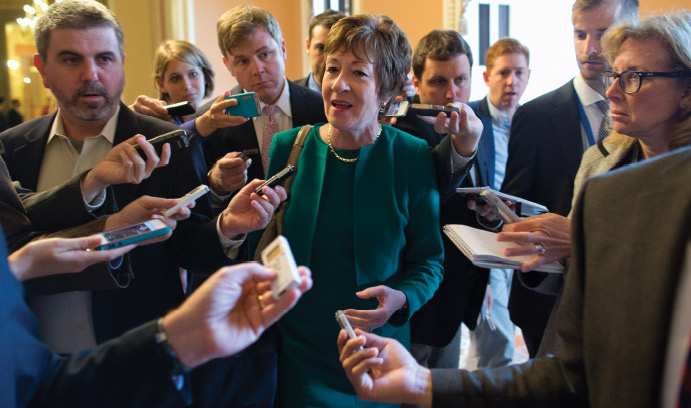Beyond 'Blanket Truths'

Corinne Post strives to better understand the circumstances in which women thrive as leaders. Here, Sen. Susan Collins, a key figure in the movement to end the government shutdown in 2013, speaks to reporters.
In the fall of 2013, the U.S. government, held hostage by a venomous and deadlocked Congress, just barely averted a crippling default on its debt—an event that could have caused a crisis not just on Wall Street, but throughout the entire world economy. The nation—and the world—had a handful of women to thank.
Lawmakers had for weeks been locked in a historic budget showdown that ultimately saw almost the entire federal government shut down. Nearly a million federal workers were sent home. Vital services were eliminated. And the cost to the U.S. economy counted? According to some estimates, it ran in the billions.

Even despite the massive costs, however, the political fighting raged. As the standoff dragged into mid-October, Republicans and Democrats remained far from an agreement on the central issue of the shutdown—President Obama’s Affordable Care Act—and it seemed increasingly likely that the shutdown would linger on. The debt default, and all its frightening impacts, loomed as a real possibility.
That’s when a bipartisan coalition of women from the U.S. Senate stepped up to end the crisis. Maine Republican Susan Collins kick-started the effort, and quickly found allies in Republican colleagues Lisa Murkowski of Alaska and Kelly Ayotte of New Hampshire, as well as Democratic senators Barbara Mikulski, Amy Klobuchar, Jeanne Shaheen and Heidi Heitkamp.
The women held wildly different political views, but they also realized the nation, at that moment, needed a great deal less partisanship and a whole lot more leadership. Within short order, Collins and her colleagues garnered enough support from their male colleagues to bring the shutdown to an end.
“I don’t think it’s a coincidence that women were so heavily involved in trying to end this stalemate,” Collins would tell The New York Times shortly thereafter. “Although we span the ideological spectrum, we are used to working together in a collaborative way.”
Added Sen. John McCain of Arizona: “Leadership, I must fully admit, was provided primarily from women in the Senate.”
Perhaps not surprisingly, the media was quick to seize on the story, with Time magazine covering Collins’ effort under a headline that read, “Women Are the Only Adults Left in Washington.”
For Corinne Post, the 2013 government shutdown—not only the way the women helped solve it, but also the way that effort was portrayed in the media—served as timely motivation to continue work focused on women leaders in the workplace. Post, an associate professor of management at Lehigh, has long been studying issues surrounding workplace diversity, and has a particular interest in investigating how diversity can best be leveraged to enhance innovation and performance within corporations and other organizations.
Looking back on the shutdown today, Post says she recalls feeling as though the media coverage didn’t quite ring true.

And there was one basic reason why: It was all just far too simplistic.
“As a researcher, I’m always skeptical about blanket truths,” Post said. “It’s unlikely that women are always better leaders. My question was, in what type of contexts would they be more likely to make a positive difference? Are there certain qualities and characteristics that make women better leaders?”
It’s a question that Post had been exploring for years before the shutdown. In one particularly revealing study, she examined 82 teams, representing more than 800 people, who worked at 29 leading research and development companies. The data were collected in 2008 and 2010 and supported by part of a $265,000 National Science Foundation grant.
The idea of the study was not to come to the final answer as to which sex is more adept at leadership—such an answer, Post says, very likely does not exist—but rather to pinpoint the strengths unique to each, as well as some of the organizational circumstances in which each is more likely to thrive—or fail. Her study helped her do precisely that.
According to her findings, which were published in the Journal of Organizational Behavior, women appear to excel in the unique and important management task of unifying large, diverse and complex teams—teams that consist of individuals from different departments with diverse specialties, and teams whose members are spread out over a large geographic area. Such teams are notoriously difficult to manage, simply because workers in them don’t necessarily understand each other, or the work each respectively contributes.
Post found that women proved themselves to be adept in leading teams to bridge the sometimes wide gaps—in function, and in culture—between team members. Most likely, she says, that’s because women tend to be more aware of potential relationship problems and possibilities than men—and more willing and able to repair those relationships, too.
Supporting this hunch, Post found that the more complex teams she studied that were managed by women had greater cohesion and more positive, beneficial and constructive interactions than similarly complex teams that were managed by men. The individuals who reported to those women leaders, Post says, felt that they “had a voice.”
“There appear to be some key differences between men and women in the context of how they relate to others,” Post says. “Men will generally think independently, while women will think more interdependently. This makes them more likely to see success leading functionally diverse teams—those where the different groups inside of that team don’t necessarily understand each other, or trust each other, or even speak the same language, or even teams that simply are located in different places geographically.”
Moving forward, Post plans on continuing her work into the unique leadership styles and skills of women and men, with the goal of unearthing additional specific situations in which one sex or the other may be more effective, generally speaking, when it comes to organizational success. Prompted by the aversion of a political and budget crisis on the Senate floor, she is also turning her attention to understanding the potential role of female leadership styles in preventing and mitigating organizational crises.
“I’m interested in trying to unravel this a bit more,” she says. “Really, what are the qualities that women leaders bring to the workplace? I don’t see this work as being about elevating women. It’s about pulling out their unique—and sometimes invisible—behaviors and understanding how they might deliver better outcomes.”
Women on Boards
Post’s work about women team leaders ties into related research on women on corporate boards, which, popular culture claims, universally boosts firms’ performance.
But this notion doesn’t jibe with the extensive body of research that shows mixed evidence about the advantage, for firms’ bottom line, of female directors in the boardroom. Post and Kris Byron of Syracuse University gathered 140 studies linking women on boards and firm performance. The studies were divided into two groups: One set was examined for accounting returns, profitability, or how well the company used assets to generate earnings; the other for performance as defined by the market or shareholders.
Post and Byron found female board representation to be positively related to profitability. Moreover, that relationship is more positive in countries with stronger shareholder protections, perhaps because shareholder protections motivate boards to use the different knowledge, experience, and values that each member brings to the board. (Without such a strong motivation, the voices of female directors, when they are in the numerical minority, sometimes are not heard or discounted.)
The analysis also revealed that while there is little relationship between female board representation and market performance, the relationship is positive in countries with greater gender parity and negative in countries with low gender parity. Additionally, Post and Byron found that female board representation is positively related to boards’ two primary responsibilities—monitoring and strategy involvement.
Corinne Post holds the Scott Hartz ’68 Term Professorship and her research interests include diversity management; performance and innovation; gender, racial and ethnic differences in individual work experiences; career trajectories; work-family conflict; and women on boards of directors. She received her Ph.D. from Rutgers University.
Story by Tim Hyland
Posted on:






